
 Towards
the end of the Asia-Pacific War, U.S. and Japanese forces fought a
ground battle on the islands of Okinawa, forcing the local residents to
also become involved in the war. The Japanese forces, wishing to delay
the imminent battle on the mainland for as long as possible, adopted
the strategy of "war of attrition," which would hold up the movement of
the Americans on the island. The Japanese soldiers went into hiding in
underground caves and resisted the enemy, who had far superior material
power. U.S. naval gunfire and bombardment, which is now referred to as
the "Storm of Steel," lasted for three months, taking the lives of over
200,000 combatants and non-combatants as a result.
Towards
the end of the Asia-Pacific War, U.S. and Japanese forces fought a
ground battle on the islands of Okinawa, forcing the local residents to
also become involved in the war. The Japanese forces, wishing to delay
the imminent battle on the mainland for as long as possible, adopted
the strategy of "war of attrition," which would hold up the movement of
the Americans on the island. The Japanese soldiers went into hiding in
underground caves and resisted the enemy, who had far superior material
power. U.S. naval gunfire and bombardment, which is now referred to as
the "Storm of Steel," lasted for three months, taking the lives of over
200,000 combatants and non-combatants as a result.
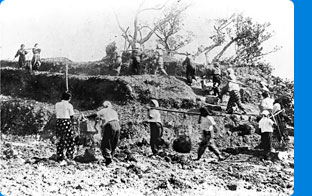 After
the Japanese Army organized the 32nd Unit (Okinawa Defense Unit) in
March 1944 (Showa 19), more and more troops came to be stationed around
Okinawa. School buildings also began to be used as barracks. As the
local students were mobilized for the building of encampments or
raising food supplies, class hours at school were gradually reduced. In
November of that year, nursing education by a military surgeon also
began to be offered, preparing the way for mobilization of students to
work in army hospitals.
After
the Japanese Army organized the 32nd Unit (Okinawa Defense Unit) in
March 1944 (Showa 19), more and more troops came to be stationed around
Okinawa. School buildings also began to be used as barracks. As the
local students were mobilized for the building of encampments or
raising food supplies, class hours at school were gradually reduced. In
November of that year, nursing education by a military surgeon also
began to be offered, preparing the way for mobilization of students to
work in army hospitals.
Photo: Work to increase food supplies
 Deployment of the Student Corps:
Deployment of the Student Corps:
On the
main island of Okinawa at the time of the Battle of Okinawa, there were
21 male and female secondary schools. As the battle began,
students were mobilized from all these schools. While female students
worked mainly as nurses, male students were divided into upper-grade
and lower-grade students. The former were organized into the "Blood and
Iron Loyalist Students Corps" and the latter into the "Signal Corps." Of
all the students in Okinawa at that time, as many as 2,000 perished on
the battlefield.
1. The Men's Division of Okinawa Normal School (Shihan)
The Blood and Iron Loyalist Student Corps of the Normal School
2. Okinawa First Junior High School (Icchû)
The First School Blood and Iron Loyalist Student Corps /
The First School Signal Corps
3. Okinawa Second Junior High School (Nichû)
The Second School Blood and Iron Loyalist Student Corps /
The Second School Signal Corps
4. Okinawa Third Junior High School (Sanchû)
The Third School Blood and Iron Loyalist Student Corps /
The Third School Signal Corps
5. Okinawa Prefectural School of Agriculture and Forestry (Nôrin)
The Agriculture and Forestry School Blood and Iron Loyalist Student Corps
6. Okinawa Prefectural School of Fishery (Suisan)
The Fishery School Blood and Iron Loyalist Student Corps /
The Fishery School Signal Corps
7. Okinawa Prefectural School of Technology (Kôgyô)
The Technology School Blood and Iron Loyalist Student Corps /
The Technology School Signal Corps
8. Naha Municipal Commercial and Industrial School (Shôkô)
The Blood and Iron Loyalist Student Corps of the Naha Commercial and Industrial School /
The Signal Corps of Naha Commercial and Industrial School
9. Kainan Junior High School (Kainan)
Kainan School Blood and Iron Loyalist Student Corps /
Kainan School Signal Corps
10. Okinawa Prefectural Miyako Junior High School (MIyakochû)
The Miyako School Blood and Iron Loyalist Student Corps
11. Okinawa Prefectural Yaeyama Junior High School (Yaeyamachû)
The Yaeyama School Blood and Iron Loyalist Student Corps
12. Okinawa Yaeyama Agricultural School (Yaenô)
The Yaeyama Agricultural School Blood and Iron Loyalist Student Corps /
The Yaeyama Agricultural School Female Student Corps
13. Okinawa Female Normal School
The Himeyuri Student Corps
14. Okinawa First Girls' High School
The Himeyuri Student Corps
15. Okinawa Second High School for Girls
The Shiraume (White Plum) Student Corps
16. Okinawa Third High School for Girls
The Nagoran (Nago Orchid) Student Corps
17. Okinawa Prefectural Shuri High School for Girls
The Zuisen (Pure Spring) Student Corps
18. Sekitoku High School for Girls
The Sekitoku (High Virtue) Student Corps
19. Showa High School for Girls
The Deigo (Red Blossom) Student Corps
20. Okinawa Prefectural Miyako High School for Girls
Miyako Girls' High School Student Corps
21. Okinawa Prefectural Yaeyama Higher School for Girls
Yaeyama Girls' High School Student Corps
At midnight on the 23rd of March, 1945 (Showa 20), the day when the U.S. forces began landing on Okinawa, the students from the Okinawa Female Normal School and the Okinawa First Girls' High School, guided by 18 teachers, headed for the Okinawa Army Field Hospital in Haebaru. Among those students were some senior members who had been awaiting their imminent graduation day. Some students had been hoping to evacuate earlier but had missed the chance, while there were others who had been called back to school from their homes. As some students who were initially not at school that day also rushed from home to join the others in Haebaru, the total number of mobilized students reached 222 in the end.
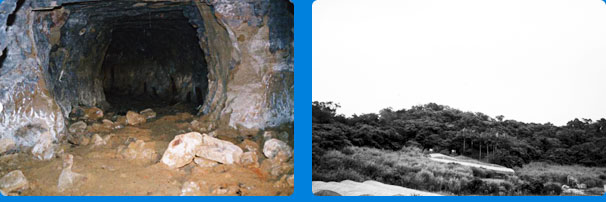 The
Okinawa Army Field Hospital to which the students were mobilized was
located on a gently sloping hill in Haebaru, five kilometers southeast
of Naha City. Forty or so caves were dug into the side of the hill, and
the "hospital wards" consisted merely of lines of poorly-built bunk
beds placed along unprotected mud walls. The students were assigned to
different caves and began their work. After the landing of the U.S.
forces on the main island of Okinawa on April 1, more and more wounded
soldiers were brought to the caves from the battlefront. As the number
of wounded soldiers began to increase, the students were forced to work
day and night with hardly any time to sleep.
The
Okinawa Army Field Hospital to which the students were mobilized was
located on a gently sloping hill in Haebaru, five kilometers southeast
of Naha City. Forty or so caves were dug into the side of the hill, and
the "hospital wards" consisted merely of lines of poorly-built bunk
beds placed along unprotected mud walls. The students were assigned to
different caves and began their work. After the landing of the U.S.
forces on the main island of Okinawa on April 1, more and more wounded
soldiers were brought to the caves from the battlefront. As the number
of wounded soldiers began to increase, the students were forced to work
day and night with hardly any time to sleep.
The hospital caves were filled with blood, pus, and bodily waste, and
groaning and shouting by the injured soldiers was heard continuously.
The students not only had to tend the sick and wounded but also had to
carry out the tasks of bringing food and water, sending messages, and
burying the dead. These were very dangerous tasks, for they had to go
out of the caves into the line of fire.
When the students heard that they would be placed in the Army Field
Hospital, they assumed that it would involve nursing work at a safe
hospital ward over which a Red Cross flag was hoisted, and that there
would be no fear of gunfire. However, in reality, the situation was no
different than the front line: they were placed on the battlefield
under a continuous barrage of shellfire.
Left Photo: Interior of the Second Surgical Cave, Okinawa Army Field Hospital
Right: The hill in Haebaru where the Okinawa Army Field Hospital was located
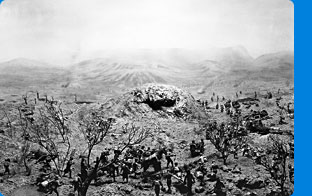 In
late May, the U.S. forces approached Shuri, where the headquarters of
Japan's 32nd Army was located. The Japanese Army, planning a war of
attrition in order to delay the invasion of the mainland by the
Americans, began retreating to the southern part of Okinawa Island.
In
late May, the U.S. forces approached Shuri, where the headquarters of
Japan's 32nd Army was located. The Japanese Army, planning a war of
attrition in order to delay the invasion of the mainland by the
Americans, began retreating to the southern part of Okinawa Island.
On May 25, an evacuation order was also issued to the Army Field
Hospital. Some students tended to patients who could walk, while others
carried their injured friends on stretchers or carried medicine and
documents in their rucksacks; they all made their way towards the south
amid a barrage of shells. The roads towards the south had been turned
into swamps by days of bombardment and persistent rain, and were filled
with civilians and soldiers who were trying to evacuate. Countless
bodies lay scattered around, and severely wounded patients who had lost
their limbs were crawling in the mud.
In each hospital cave, the patients who were too ill to walk were given
poison. Two students who were gravely wounded and could not be moved
were left behind in Haebaru.
Photo: Retreating to the South (a diorama)
The teachers and students who moved from
the Army Field Hospital and its separate clinical caves in Haebaru
gathered in what is now Ihara, Itoman City. There were many natural
caves in this area—called "gama" in the Okinawan language—and a number
of civilians were seeking shelter in these caves. The civilians who had
been hiding in the caves were forced out by the army, and the Army
Field Hospital members took shelter in six separate gama.
In effect, the Army Field Hospital had run out of most medical
equipment and medications by this time and had ceased to function as a
hospital. There were not even caves suitable for receiving injured
soldiers. The students still carried out the tasks of securing food and
water and sending messages in the midst of shellfire.
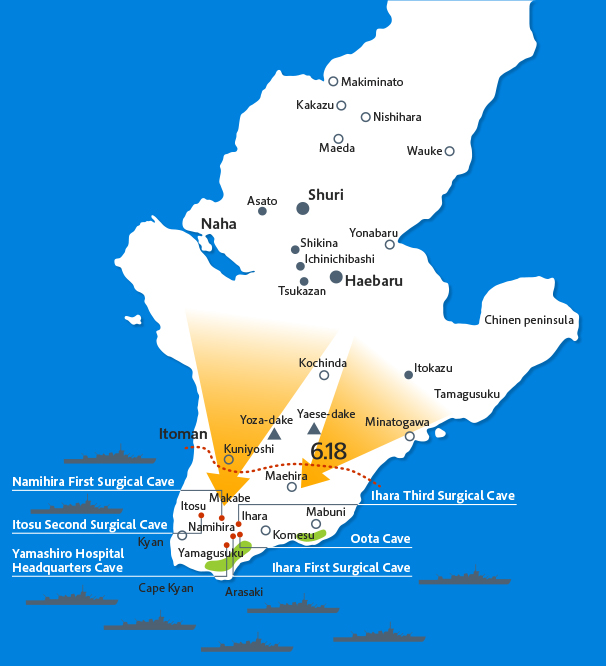 At
midnight on June 18th, a deactivation order was issued to the students
at the Army Field Hospital. The U.S. forces were closing in, and there
was heavy bombardment outside. Nevertheless, the students had to leave
the caves and fend for themselves from then on.
At
midnight on June 18th, a deactivation order was issued to the students
at the Army Field Hospital. The U.S. forces were closing in, and there
was heavy bombardment outside. Nevertheless, the students had to leave
the caves and fend for themselves from then on.
In late June, the 32nd Army (Okinawa Defense Forces) was destroyed.
Commander Ushijima did not allow the surviving soldiers to surrender
and, before committing suicide himself, ordered every soldier to fight
till the last moment. Even after the death of the Commander, a large
number of civilians and soldiers were unable to escape the attack by
the Americans and were killed on the battlefield.
During the 90 days from the beginning of their mobilization in March
until the issuance of deactivation order, 19 Himeyuri students were
killed; in stark contrast, around 100 students died within the first
few days after the deactivation of the corps.

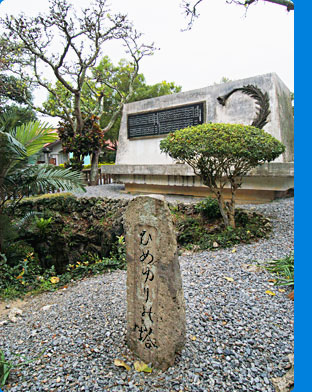 The
gama (cave) over which the cenotaph for the Himeyuri students currently
stands is called "Ihara Third Surgical Cave," for this was the place
where the Third Department of Surgery of the Army Field Hospital moved
after their retreat to the south in Okinawa. There were around 100
people in this cave, including the Himeyuri students and other hospital
workers, signal corps members, and local residents. Early on the
morning of June 19th, immediately after the deactivation of the student
corps, the cave came under attack by the U.S. military, and about 80
people were killed as a result.
The
gama (cave) over which the cenotaph for the Himeyuri students currently
stands is called "Ihara Third Surgical Cave," for this was the place
where the Third Department of Surgery of the Army Field Hospital moved
after their retreat to the south in Okinawa. There were around 100
people in this cave, including the Himeyuri students and other hospital
workers, signal corps members, and local residents. Early on the
morning of June 19th, immediately after the deactivation of the student
corps, the cave came under attack by the U.S. military, and about 80
people were killed as a result.
Photos: The Himeyuri Cenotaph and Ihara Third Surgical Cave

 Although
the Himeyuri students escaped from the cave after the deactivation of
their unit, they could not find any other cave to hide in. They hid
themselves among thick bushes of cycads or screw pine trees during the
day and moved towards the coast at night, when the attack subsided.
Those who were injured dragged themselves along to escape from danger;
some assisted their wounded friends in moving forward. Sometimes the
students' injuries were so grave that they just collapsed on the spot.
Some were hit by shell blasts, while others were engulfed by huge waves
along the coast. Many others had nowhere to escape and died while
screaming out their parents' names. Since the students were most
frightened of getting caught by the U.S. military, some of them killed
themselves with hand grenades.
Although
the Himeyuri students escaped from the cave after the deactivation of
their unit, they could not find any other cave to hide in. They hid
themselves among thick bushes of cycads or screw pine trees during the
day and moved towards the coast at night, when the attack subsided.
Those who were injured dragged themselves along to escape from danger;
some assisted their wounded friends in moving forward. Sometimes the
students' injuries were so grave that they just collapsed on the spot.
Some were hit by shell blasts, while others were engulfed by huge waves
along the coast. Many others had nowhere to escape and died while
screaming out their parents' names. Since the students were most
frightened of getting caught by the U.S. military, some of them killed
themselves with hand grenades.
Between the 20th and 23rd of June,
many students were taken to U.S. collection centers. However, some
students went into hiding for more than two months without even knowing
about the surrender of Japan; it was as late as August 22nd when they
were finally received at refugee camps.
Photo: The coast of Arasaki
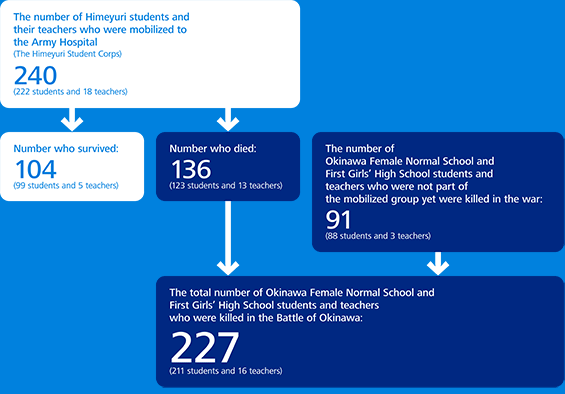
Himeyuri
students were mobilized for work at the Okinawa Army Field Hospital on
March 23rd. On that day, Okinawa came under heavy aerial bombardment
and naval gunfire, and the entire island was in a state of turmoil.
Some of the students who came to school from their homes each day were
thus unable to reach the school and remained with their family or
assisted the troops stationed in their neighborhoods. Many of the
students who were not sent to the hospital to work were also engulfed
in the battle and lost their precious lives as a result.
In total, 227 people from the Okinawa Female Normal School and the
First Girls' High School were killed in the Battle of Okinawa: 136
students and teachers died after their mobilization to the Army Field
Hospital; 91 students and teachers died in other places.



